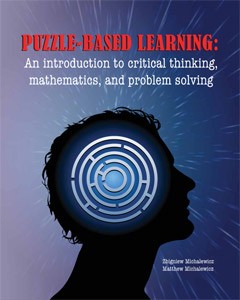Introduction to critical thinking, mathematics, and problem solving.
 Most of us never learn how to think about solving problems. Throughout our education, we are forced to focus on textbook questions. So, without much thinking, we apply the material from each chapter to solve the problems at the end of each chapter. With this type of approach to “problem solving”, it is not surprising that we are ill prepared for framing and addressing real-world problems. When we enter the real world, we suddenly find that problems do not come with instructions or textbooks …
Most of us never learn how to think about solving problems. Throughout our education, we are forced to focus on textbook questions. So, without much thinking, we apply the material from each chapter to solve the problems at the end of each chapter. With this type of approach to “problem solving”, it is not surprising that we are ill prepared for framing and addressing real-world problems. When we enter the real world, we suddenly find that problems do not come with instructions or textbooks …
The approach taken in this book seeks to teach us how to frame and solve “unstructured” problems.
The approach taken in this book – called Puzzle-based Learning – seeks to address this deficiency by teaching us how to frame and solve “unstructured” problems. Based on a variety of puzzles that are inherently unstructured, this book increases our mathematical awareness and ability to solve difficult problems. Puzzle-based Learning is based on the earlier ideas of Gyorgy Polya and Martin Gardner (among many others), and introduces elements of mathematics, science, and critical thinking.
“Better to have the money than to calculate it; better to have the experience than to define it.”
Anthony de Mello, One Minute Wisdom
“Better to have the problem-solving skills than to discuss them.”
Zbigniew & Matthew Michalewicz, Puzzle-based Learning
This book is the result of many years of experience in educating young engineers, mathematicians, computer scientists, and businessmen at many universities in many countries (USA, Mexico, Argentina, New Zealand, Australia, South Korea, Japan, China, Poland, Sweden, Germany, Spain, Italy, France, UK). Limited experiments using puzzle-based learning with these students have already produced outstanding course evaluations and countless comments that praise the problem-solving orientation of the course. We believe that the main reasons behind most students’ enthusiasm for puzzle-based learning are:
- Puzzles are educational, but they illustrate useful (and powerful) problem-solving rules in a very entertaining way.
- Puzzles are engaging and thought-provoking.
- Contrary to many textbook problems, puzzles are not attached to any chapter (as is the case with real-world problems).
- It is possible to talk about different techniques (e.g., simulation, optimization), disciplines (e.g. probability, statistics), or application areas (e.g. scheduling, finance) and illustrate their significance by discussing a few simple puzzles. At the same time, the students are aware that many conclusions are applicable to the broader context of solving real-world problems.
We have organized this book in the following way: We begin with the Introduction (what a nice section to start with!), which explains in more detail the motivation behind this text. This is followed by thirteen chapters that are grouped into three parts. Part I presents the first three chapters, each of which discusses a simple problem-solving rule. Needless to say, each rule is illustrated by a collection of the best puzzles we could find. Part II presents eight chapters, from 4 to 11. These chapters cover various aspects of problems and problem solving by discussing constraints, optimization, probability, statistics, simulations, pattern recognition, and strategy. This part of the text makes a clear connection between various puzzles and different branches of science. It also includes a discussion on many mathematical problem-solving principles. Part III, on the other hand, consists of just two chapters that can be used as assignments (a collection of puzzles with and without solutions, respectively). These chapters include many puzzles that illustrate the applicability of various problem-solving rules and mathematical principles in a variety of domains.